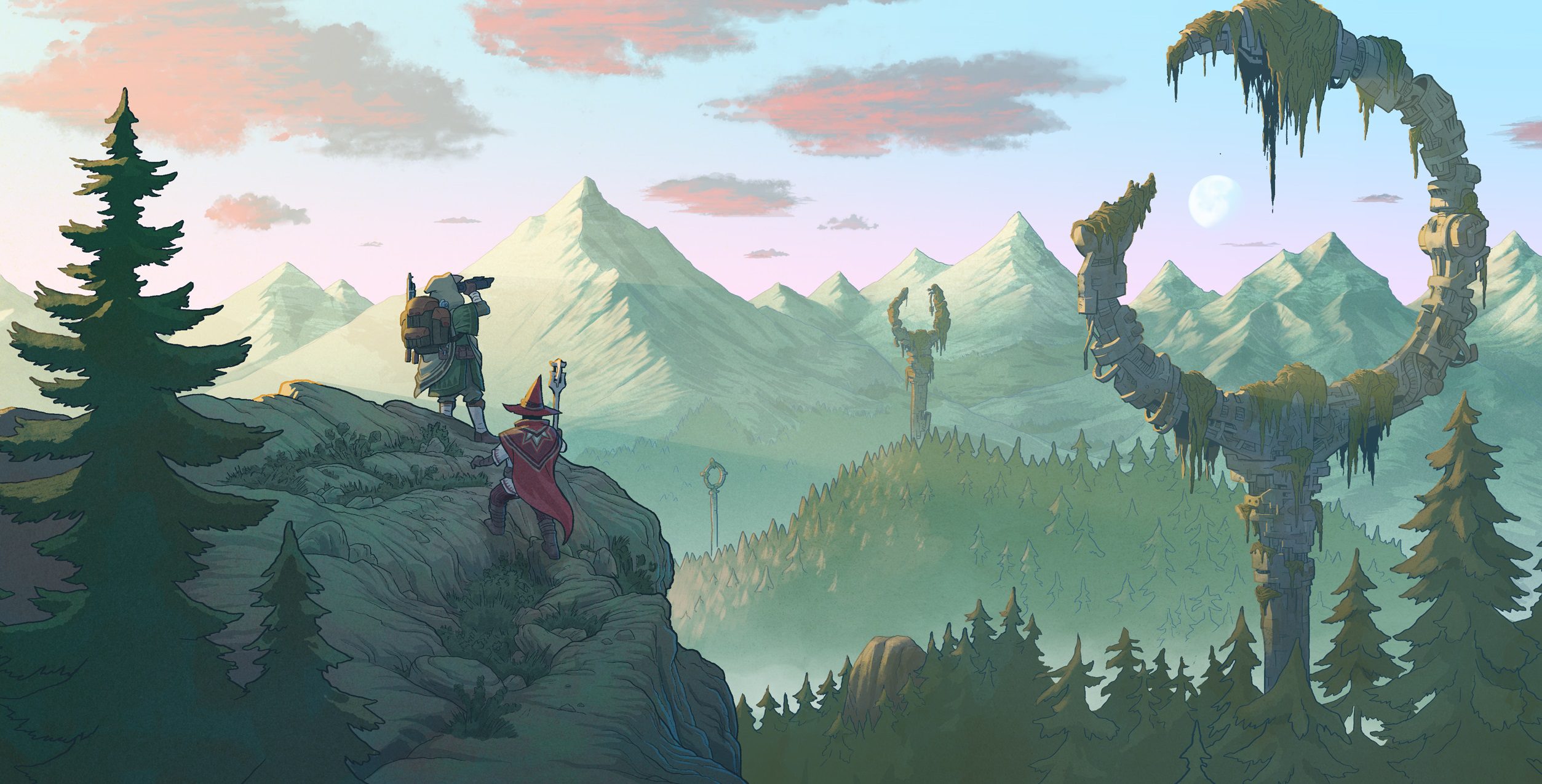The card game Kickstarter launches this week
[Update: The Earthborne Rangers Kickstarter has blown past its goal, and is in the final stretch of the campaign. At present, the team has released a Tabletop Simulator (TTS) demo module for people to try before they pledge.]
Andrew Navaro has been looking to change the tabletop industry for the better for some time. If you’re keen on card/board/miniature games you may have heard his name come up. He was with Fantasy Flight Games for nearly two decades, working his way up from a senior graphic designer all the way to head of studio, with one of his most recent works involving overseeing production of Marvel Champions. But in the last few years he’s been working on a passion project that’s very nearly ready to be unleashed into the world via Kickstarter this week: the cooperative card game Earthborne Rangers.
We had the chance to not only play a small module of the game, but speak to Navaro about some of its concepts that he hopes will change the industry forever.

You may have immediately noticed the striking art (much of which is done by Evan Simonet), and I don’t blame you. Art and theme can make or break a lot of card games, and Navaro wanted to heavily focus on both of those aspects for Earthborne Rangers. I inquired about any potential Studio Ghibli influences, and Navaro was very quick to respond:
“We’re trying to hit something similar to what you might see in an animated film: simply colored and shaded characters set against painterly backdrops. We’re very much inspired by the work of Studio Ghibli and of Moebius, though the list of artists and creators that have influenced and inspired us throughout our lives is a mile long.”
One huge aspect of the game, which the art conveys strikingly, is ecological preservation: both in the actual card game and in real life. Earthborne takes place in a civilization where the world’s superpowers actually united and saved the planet, but there’s still more work and stewardship to be done. As a result, Navaro is specifically aiming for a pacifist focus for the game, where problems aren’t always solved through violence like most cooperative card games (or games in general really). Navaro is putting his money where his mouth is, and when asked about how that ecological production would take place, gave us an interesting reply:
“It will all come down to the total number of Kickstarter backers and where those backers are located geographically. Many Kickstarter campaigns feature a litany of stretch goals that get thrown into the product as financial milestones are met such as miniatures, cards, or more miniatures.
The Earthborne Rangers campaign will approach stretch goals differently. It will stay in the spirit of sustainability, and speak directly to the mission of the company.”
As a result, Navaro will be unlocking “regional manufacturing stretch goals,” which will involve separate print runs for the US, UK, and EU. This significantly cuts down on waste, as the tabletop industry enters an uncertain era with myriad shipping freight issues. He also has a very unique take, backed by decades of experience, on why it’s important to move the industry in this direction, and why the winds of change are so important:
“I feel that a lot of companies are stuck in that same rut, continually trying to keep PPU [price per unit] costs as low as possible, and it’s the most significant factor in their perceived inability to adopt more sustainable practices. It simply costs more money right now to manufacture games sustainably than to not. Plain and simple.
I feel like they don’t believe that customers care, or think about, where their products come from or how they’re made. As a result, regardless of how they may feel personally about the environment or sustainability, they’re terrified of raising prices to compensate.”
According to Navaro, all he needed is a little help from a friend:
“I took a lot of things for granted, and I made a lot of inaccurate assumptions, while part of a massive business that was set in its ways. It wasn’t until I had made the decision to leave the company that the fact that I could do things completely differently fully dawned on me. A friend of mine who worked with me for a short time on Earthborne turned me on to a book called The Responsible Company by the founder of Patagonia, Yvon Chouinard, and a lot of what Mr. Chouinard wrote in that book really resonated with me. The premise of the book, in simplest terms, is that as humans we like to make things.
Everything we make causes some harm to the Earth, so if we’re going to make things, we should do as little harm as possible. Once I started thinking about what that could mean for the tabletop industry, and I considered just how far we could go if we were willing, I started to embrace the idea of trying to make an ambitious hobby-style game that was sustainable from top to bottom.”

So how is the game? True to his word, in the hour-ish walkthrough/playthrough I experienced, it does feel unique to Navaro’s vision in that there is a large emphasis on exploration and emergent role-playing rather than an overwhelming amount of conflict. Many cards feature small numerical reference numbers that are linked to passages in an insert that are read aloud, which adds an “NPC” element to the game and adds potential narrative choice. As a ranger (described as a mix between a park ranger and a peace keeper) you’ll explore sections of Earthborne in “day” chunks, which end after a certain period of time (like following an emptied deck). According to Andrew Fischer (game designer and FFG veteran of 10 years), who demoed Earthborne for us, it’s “less about good and evil and more about what is the best approach.”
From there, the deckbuilding and choices begin. Navaro wants to move away from cookie-cutter deckbuilding and more toward “backstories,” which add more of a narrative aspect to your deck and how you play. This is facilitated through roles (classes), which plus-up said strategy based on the deck you choose. For the purposes of the demo, we had access to the Artificer (which is keen to build up an engine of cards to diversify their options on any given turn) and the explorer (who is more focused on one-off cards and comboing them at the cost of fatigue, a value that can end your day quicker).
Think of Earthborne Rangers like an open world RPG. You’ll embark upon a campaign for multiple days, and each day is a session. Players start subsequent days in the same location you ended the last one in, with the ability to pursue the critical path or embark on side missions. Navaro explains that the booklet for the game will contain a map, with different mission objectives available throughout your quest. Our mission for the demo was to explore White Sky and make contact with the villagers there; parleying with them and reaping the benefits of their fishing skills. Along the way various elemental hazards and hardships got in our way via the encounter deck: itself made up of various modules that you can mix and match, some of which involve the region you’re in.
Taking on those hardships is represented by committing tokens (which are a set value at the start, but can be acquired through various means) or cards to a skill test. From there you’ll draw a card from the “challenge deck” (which is a lot like the chaos bag in Arkham Horror: The Card Game), which modifies that final value. If you succeed, usually something good happens like additional progress toward an objective, or it grants a bonus effect (like healing fatigue). If not, you fail and are often fatigued.

It took me a bit of time to parse all of the different tokens and tests, and how to commit to each one, but over time it all started to come together. Even with our brief time with this limited module I really dug how out of the box the game is, as most publishers are absolutely not keen on making games that are more about the journey than conflict. Even in the small chunk of the game I played I was able to see Navaro’s vision come to life. How everyone else will respond to that vision is going to be very interesting to see in the coming months.
If you want to change up how the game is played, you can swap in or out different “weather effects,” which are akin to environments that drastically alter how easy or difficult a particular run is. It’s a clever way to dial the difficulty level down or up without sacrificing the core throughput. But I had to follow up with Navaro to get a feel for what audience the game was for. As it turns out, basically everyone:
“If a stiff challenge is something that you enjoy, there will be an ‘insane level’ weather card (or cards) that will make the game far more difficult. Beyond that, since the game utilizes modular sets of cards, those sets can be combined in all sorts of ways to provide additional challenges to players who want it. Alternatively (or additionally), players can tune their decks and their stats in such a way as to make the game more difficult even without tinkering with the path deck or playing with a punishing weather card.
I will say, however, that if old school punch-the-player-in-the-face co-op mechanics are what you’re looking for, this game probably isn’t for you. There are plenty of other games out there that provide that experience. With Earthborne Rangers, I’m hoping to do something different. When you play it, I hope you’ll discover that there’s more to this genre than what you may have thought possible, and that there’s a lot of fun to be had outside of constant conflict and desperate struggle.”
To that end, Navaro has ensured that the game is extremely welcoming, and was “sure to play with both experienced card gamers and newcomers.” He explains that both groups picked up the game quickly, before elaborating further on how low the barrier of entry is:
“From my experience, I usually have no idea what I’m doing for the first hour or so when I’m playing a card game for the first time, and then the game steadily begins to make sense by the end. I think Earthborne Rangers avoids that problem because of how the narrative actions are presented on the table.
When the choices on your turn are things like, do I want to avoid this mountain lion, or would I like to speak with this villager, or would I like to soak my feet in this hot spring, you can make decisions based on theme, not get bogged down in the technicalities of the rules, and just have fun with it. I feel that Earthborne Rangers is a great entry point to the genre. Not only because the rules are relatively easy to understand, but because the theme and the art are so approachable.”

So what’s in store for the future of Earthborne? Just this Kickstarter? Not if Navaro has anything to say about it:
“A lot will depend on the level of success of the Kickstarter campaign. If we get a ton of support, we’ll be able to increase our production capacity and develop all sorts of content for Earthborne Rangers and for the game system we’ve developed. The world of Earthborne is much larger than the mountain valley in which Earthborne Rangers takes place. It is my hope to craft more stories in the setting and shine a light on other areas of the game world.
I have ideas as to where I’d like the story to go next, but we’ll need the support of the community to make it happen. I’d love to do all sorts of expansions for Earthborne Rangers along with big, splashy products as massive as the core set that introduce new geographical regions to the game. When and how those products manifest will depend on the level of support we receive and on what portions of the game resonate the most with players.”
Navaro isn’t going at it alone either. He’s assembled a super-team of sorts, with the Sadler Brothers (Adam and Bradley) involved in the core rules design and development, Sam Gregor-Stewart handling fiction and content development, Brooks Flugaur-Leavitt and (the previously mentioned) Andrew Fischer working on additional design, with (also previously mentioned!) Evan Simonet handling art and Joe Banner taking care of illustrations.
The Kickstarter for Earthborne Rangers launches tomorrow, and you can find it right here when it does. In the meantime, check out some cards!
Also, here’s an elevator pitch:
And here’s a gameplay/rules breakdown:













